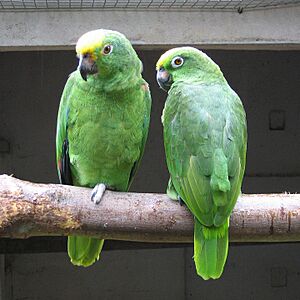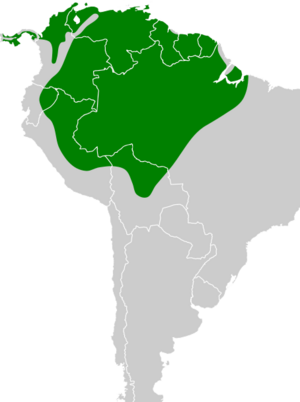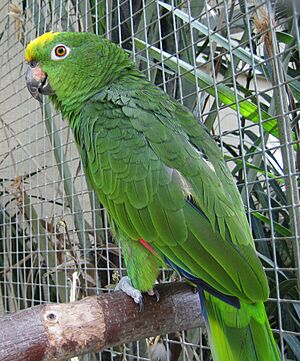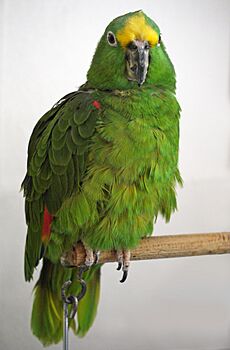Yellow-crowned amazon facts for kids
Quick facts for kids Yellow-crowned amazon |
|
|---|---|
 |
|
| At Well Place Zoo, England | |
| Conservation status | |
| Scientific classification | |
| Genus: |
Amazona
|
| Species: |
ochrocephala
|
 |
|
The yellow-crowned amazon (Amazona ochrocephala) is a type of parrot. It is also called the yellow-crowned parrot. These colorful birds live in warm, tropical parts of South America, Panama, and the islands of Trinidad and Tobago.
Scientists group animals together based on how they are related. Sometimes, the yellow-crowned amazon is considered a single species. Other times, the Yellow-headed amazon and yellow-naped amazon are seen as very close relatives or even types of the yellow-crowned amazon. This article mainly talks about the most common yellow-crowned amazon parrots.
Contents
Understanding Yellow-Crowned Amazon Parrots
The yellow-crowned amazon was first officially described in 1788. A German scientist named Johann Friedrich Gmelin gave it the scientific name Psittacus ochrocephalus. Later, it was moved to the group of parrots called Amazona. This group was named by a French scientist, René Lesson, in 1830. He thought these parrots came from the Amazon jungles.
The name ochrocephala comes from ancient Greek words. Ōkhros means "pale yellow" and -kephalos means "-headed." So, its name literally means "pale yellow-headed parrot."
Scientists recognize four main types, or subspecies, of the yellow-crowned amazon:
- A. o. panamensis: Found in western Panama and northwest Colombia.
- A. o. ochrocephala: Lives in eastern Colombia, Venezuela, the Guianas, and northern Brazil.
- A. o. xantholaema: Found on Marajó Island, off northern Brazil.
- A. o. nattereri: Lives in southern Colombia, eastern Peru, northern Bolivia, and western Brazil.
Scientists sometimes find it tricky to decide if these different types are separate species or just subspecies. This is because they look very similar. They also live close to each other in some areas.
What Do Yellow-Crowned Amazons Look Like?
Yellow-crowned amazons are about 33 to 38 centimeters (13 to 15 inches) long. Like most amazon parrots, they have a short, square-shaped tail. Their feathers are mostly green.
They have dark blue tips on their wing feathers. They also have a red patch on their wings. This red patch is often hard to see when the bird is sitting still. The amount of yellow on their head can be different. Some have just a little yellow on the top of their head. Others, like the xantholaema subspecies, have most of their head covered in yellow.
All yellow-crowned amazons have a white ring around their eyes. Their beak is usually dark with a large gray or reddish spot on the top part. However, the panamensis subspecies has a horn-colored (light gray) beak. Male and female parrots look the same. Young parrots have less yellow and red on their feathers than adult birds.
Where Yellow-Crowned Amazons Live
Yellow-crowned amazons live in the Amazon basin and the Guianas region of South America. You can also find them in northwestern South America and Panama. Some have even been introduced to Grand Cayman island.
These parrots live in many different places. They like tropical forests, both wet and dry. They also live in woodlands, mangrove swamps, and savannas (grassy areas with scattered trees). You might even see them in farms or suburban areas. They usually live in low-lying areas. However, they can be found up to 800 meters (2,600 feet) high in the Andes mountains.
A group of about 60 wild yellow-crowned amazons has been living in Stuttgart, Germany, since the mid-1980s.
Yellow-Crowned Amazon Behavior
What They Eat
Yellow-crowned amazons usually live in pairs or small groups of up to 30 birds. Sometimes, larger groups gather at places where they can eat clay. Their diet includes many different things. They eat fruits, nuts, seeds, berries, blossoms, and leaf buds. They especially like maize (corn) and cultivated fruits from farms. Foods with too much sugar or salt can be bad for them.
Reproduction and Life Cycle
Yellow-crowned amazons build their nests in hollows. These can be in trees, palm trees, or even termite mounds. The female parrot usually lays two to three eggs. The eggs hatch after about 26 days. The young chicks stay in the nest for about 60 days after hatching. Then, they are ready to leave the nest and explore on their own.
Protecting Yellow-Crowned Amazons
The yellow-crowned amazon is considered a species of "least concern" by BirdLife International and IUCN. This means they are not currently in danger of disappearing. Even though their numbers might be going down, they are not decreasing fast enough to be considered "near threatened" yet.
Like most parrots, they are listed on Appendix II of CITES. This means that trading them internationally is controlled. This helps make sure that too many are not taken from the wild. These parrots live in many protected areas. They are still quite common in much of their natural home range.




